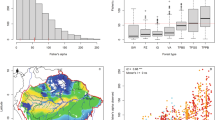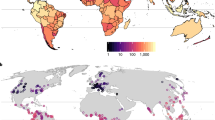Abstract
Large-scale patterns of Amazonian biodiversity have until now been obscured by a sparse and scattered inventory record. Here we present the first comprehensive spatial model of tree α-diversity and tree density in Amazonian rainforests, based on the largest-yet compilation of forest inventories and bolstered by a spatial interpolation technique that allows us to estimate diversity and density in areas that have never been inventoried. These data were then compared to continent-wide patterns of rainfall seasonality. We find that dry season length, while only weakly correlated with average tree α-diversity, is a strong predictor of tree density and of maximum tree α-diversity. The most diverse forests for any given DSL are concentrated in a narrow latitudinal band just south of the equator, while the least diverse forests for any given DSL are found in the Guayana Shield and Amazonian Bolivia. Denser forests are more diverse than sparser forests, even when we used a measure of diversity that corrects for sample size. We propose that rainfall seasonality regulates tree α-diversity and tree density by affecting shade tolerance and subsequently the number of different functional types of trees that can persist in an area.
Similar content being viewed by others
References
Burrough P.A. and McDonnel R.A. 1998. Principles of Geographic Information Systems. Oxford University Press, Oxford, UK.
Bush M.B. 1994. Amazonian speciation: a necessarily complex model. Journal of Biogeography 21: 5–17.
Cade B.S., Terrel J.W. and Schroeder R.L. 1999. Estimating effects of limiting factors with regression quantiles. Ecology 80: 311–323.
Condit R., Foster R.B., Hubbell S.P., Sukumar R., Leigh E.G., Manokaran N. et al. 1998. Assessing forest diversity on small plots: calibration using species¶individual curves from 50-ha plots. In: Dallmeier F. and Comiskey J.A. (eds), Forest Biodiversity Research, Monitoring and Modelling. Conceptual Background and Old World Case Studies. MAB Series Vol. 20. UNESCO, Paris, pp. 247–268.
Condit R., Pitman N., Leigh E.G. Jr., Chave J., Terborgh J., Foster R.B. et al. 2002. Beta-Diversity in Tropical Forest Trees. Science 295: 666–669.
Colwell R.K. and Lees D.C. 2000. The mid-domain effect: geometric constraints on the geography of species richness. Trends in Ecology and Evolution 15: 70–76.
Clinebell R.R., Phillips O.L., Gentry A.H., Stark N. and Zuuring H. 1995. Prediction of neotropical tree and liana species richness from soil and climatic data. Biodiversity and Conservation 4: 56–90.
Conservation International 1990. Workshop 90. Biological Priorities for Conservation in Amazonia. Conservation International, Washington, DC.
Fisher A.A., Corbet A.S. and Williams C.B. 1943. The relation between the number of species and the number of individuals in a random sample of an animal population. Journal of Animal Ecology 12: 42–58.
Gaston K.J. 2000. Global patterns in biodiversity. Nature 504: 220–227.
Gentry A.H. 1988a. Tree species richness of upper Amazonian forests. Proceedings of the National Academy of Sciences, USA 85: 156–159.
Gentry A.H. 1988b. Changes in plant community diversity and floristic composition on environmental and geographical gradients. Annals of the Missouri Botanical Garden 75: 1–34.
Givnish T.J. 1999. On the causes of gradients in tropical tree diversity. Journal of Ecology 87: 193–210.
Hall J.B. and Swaine M.D. 1976. Classification and ecology of closed-canopy forest in Ghana. Journal of Ecology 64: 913–951.
Henkel T.W. in press. Monodominance in the ectomycorrhizal Dicymbe corymbosa (Caesalpiniaceae) from Guyana. Journal of Tropical Ecology.
Hille Ris-Lambers J., Clark J.S. and Beckage B. 2000. Density-dependent mortality and the latitudinal gradient in species diversity. Nature 417: 732–735.
Huston M.A 1980. Soil nutrients and tree species richness in Costa Rican forests. Journal of Biogeography 7: 147–157.
Huston M.A. 1994. Biological Diversity. The Coexistence of Species on Changing Landscapes. Cambridge University Press, Cambridge, UK, 681 pp.
Kalunzy S.P., Vega S.C., Cardoso T.P. and Shelly A.A. 1998. S1 Spatial Stats. User's Manual for Windows and UNIX. Mathsoft Inc., Seattle, Washington.
Kikuzawa K. 1996. Geographical distribution of leaf life span and species diversity of trees simulated by a leaf-longevity model. Vegetatio 122: 61–67.
Kleidon A. and Mooney H.A. 2000. A global distribution of biodiversity inferred from climatic constraints; results from a process-based modelling study. Global Change Biology 6: 507–523.
Koenker R.W. and Bassett G.W. 1978. Regression quantiles. Econometrica 46: 33–50.
Leigh E.G. 1995. Epilogue: research on Barro Colorado Island 1980¶1994. In: Leigh E.G., Rand A.S and Windsor D.M. (eds), The Ecology of a Tropical Rain Forest, Seasonal Rhythms and Long Term Changes. Smithsonian Institution Press, Washington, DC, pp. 496–503.
Mayle F.E., Burbridge R. and Killeen T.J. 2000. Millennial-scale dynamics of southern Amazonian rain forests. Science 290: 2291–2294.
Myers N., Mittermeier R.A., Mittermeier C.G., da Fonseca G.A.B. and Kent J. 2000. Biodiversity hotspots for conservation priorities. Nature 403: 853–858.
de Oliveira A.A. and Mori S.A. 1999. A central Amazonian terra firme forest I. High tree species richness on poor soils. Biodiversity and Conservation 8: 1219–1244.
Phillips O.L., Hall P., Gentry A.H., Sawyer A.S. and Vasquez R. 1994. Dynamics and species richness of tropical rain forests. Proceedings of the National Academy of Sciences, USA 2805–2809.
Pitman N.C.A. 2000. A large-scale inventory of two Amazonian tree communities, Ph.D. Thesis, Duke University, Durham, North Carolina.
Prance G.T. 1982. Forest refuges: evidence from woody angiosperms. In: Prance G.T. (ed.), Biological Diversification in the Tropics. Columbia University Press, New York, pp. 137–138.
Rosenzweig M.L. 1995. Species Diversity in Space and Time. Cambridge University Press, Cambridge, UK, 436 pp.
Sombroek W. 2001. Spatial and temporal patterns of Amazon rainfall. Consequences for the planning of agricultural occupation and protection of primary forests. Ambio 30: 388–396.
Taylor L.R., Kempton R.A. and Woiwod I.P. 1976. Diversity statistics and the log-series model. Journal of Animal Ecology 45: 255–272.
Terborgh J. 1973. On the notion of favorableness in plant ecology. American Naturalist 107: 481–501.
Terborgh J. and Andresen E. 1998. The composition of Amazonian forests: patterns at local and regional scale. Journal of Tropical Ecology 14: 645–664.
ter Steege H. and Zagt R. 2002. Density and diversity. Nature 417: 698–699.
ter Steege H., Sabatier S., Castellanos H., van Andel T., Duivenvoorden J., de Oliveira A.A. et al. 2000. An analysis of Amazonian floristic composition, including those of the Guiana Shield. Journal of Tropical Ecology 16: 801–828.
Vasques-Martinez R. and Phillips O.L. 2000. Allpahuayo: floristics, structure and dynamics of a high-diversity forest in Amazonian Peru. Annals of the Missouri Botanical Garden 87: 499–527.
Venables W.N. and Ripley B.D. 1998. Modern Applied Statistics with S-plus. Springer, New York, 548 pp.
Rights and permissions
About this article
Cite this article
Ter Steege, H., Pitman, N., Sabatier, D. et al. A spatial model of tree α-diversity and tree density for the Amazon. Biodiversity and Conservation 12, 2255–2277 (2003). https://doi.org/10.1023/A:1024593414624
Issue Date:
DOI: https://doi.org/10.1023/A:1024593414624




